Equinamity-A Revolution in Horse and Rider Training
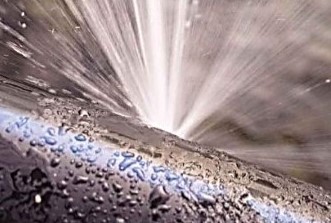
There are several problems arising from the higher speed of airflow. They include turbulence of the airflow and damage to the soft tissues of the palate. These are looked at next.
“The physics of flow underlies the behavior of all fluids. Liquids, such as plasma and crystalloid solutions, and gases, such as oxygen and sevoflurane, are all considered to be fluids. Flow (F) is defined as the quantity (Q, mass or volume) of a given fluid that passes by a certain point within a unit of time (t), most commonly expressed in liters per second. This relationship can be expressed by the equation F = Q/t. Fluid flow requires a pressure gradient (ΔP) between two points such that flow is directly proportional to the pressure differential. Higher pressure differences will drive greater flow rates. The pressure gradient establishes the direction of flow”.
Air pressure and speed, flow and impediments in the horse’s windpipe operate in apparently contradictory ways (e.g. speed up-pressure down, etc.) The following exercise shows how the speed of a liquid dramatically increases when the diameter of a nozzle is reduced.
“A nozzle with a radius of 0.250 cm is attached to a garden hose with a radius of 0.900 cm. The flow rate through hose and nozzle is 0.500 L/s. Calculate the speed of the water (a) in the hose and (b) in the nozzle.
Solution for hose (a)
First, we solve Q=A¯v for¯v1 and note that the cross-sectional area is A=πr2, yielding¯v1=QA1=Qπr21.
Substituting known values and making appropriate unit conversions yields
Solution for nozzle (b)
Using the equation which states A1¯v1=A2¯v2, solving for¯v2 and substituting πr2 for the cross-sectional area yields ¯v2=A1A2¯v1=πr21πr22¯v1=r21r22¯v1.
Substituting known values, ¯v2=(0.900 cm)2(0.250 cm)21.96 m/s=25.5 m/s, or alternatively expressed as:
Discussion
A speed of 1.96 m/s is about right for water emerging from a nozzleless hose. The nozzle produces a considerably faster stream merely by constricting the flow to a narrower tube.”
The following extract describes additional aspects of airflow dynamics.
“The upper airway is the primary conduit of airflow between the nasal passage and the lungs, allowing sufficient gas exchange between the air and the pulmonary circulation. It is a high-resistance, low-capacity ventilatory passage, and airway obstruction causes increased respiratory effort and poor performance.
Exercise demands a ventilation rate of approximately 1,500 L/min, resulting in delivery of a high volume of oxygen and elimination of a large quantity of carbon dioxide. During inspiration, negative alveolar pressure creates a force that causes environmental air movement into the lungs, whereas positive pressure drives air out of the lungs against atmospheric pressure during expiration.
During high-intensity exercise, peak pressure in the trachea is approximately –30 cm H2O during inspiration and 15 cm H2O during expiration. With a greater exercise intensity, the greater is the airflow rate and the larger the pressure change.
Airway resistance (the pressure:flow ratio) is greatly affected by airway diameter. Cylindric tube resistance (R) can be calculated using the following formula (n = gas viscosity; L = length of trachea; r = radius of trachea): R = (8 × nL) ÷ r 4 Gas viscosity, which affects the pressure:flow relationship, is constant. Because the radius is to the fourth power, a small difference in airway radius has a major impact on airway resistance.
When the air entering the trachea accelerates it can create numerous damaging throat conditions. Which are looked at next.
Before entering into the specific subject of these ailments, it is important to discount another key element of RAO/Recurrent Airway Obstruction. And that is heaves, which is quoted from Kentucky Equine in 2004:
“The athletic endeavors of horses are often beset by respiratory problems. Second only to musculoskeletal disease, respiratory compromise, when severe enough, can cut short the productive lives of horses.
Horse owners are often quick to lay blame on an “allergy” when a horse begins to cough or wheeze. An allergy is any hypersensitivity to a specific stimulus, even a stimulus that a horse has been previously exposed to without detriment. This hypersensitivity results in self-injury. The degree of debilitation caused by an allergy depends on the severity of the reaction and the number of body systems involved.
On the respiratory front, one of the most common allergies among middle-aged horses manifests itself as recurrent airway obstruction (RAO), a disease characterized by habitual cough and signs of respiratory distress that include flared nostrils, increased respiratory rate, and forced abdominal breathing. The horse may also appear anxious.
RAO was once referred to as chronic obstructive pulmonary disease (COPD), but a human condition that shared that name has significantly different symptomatology, so RAO is now the preferred name among veterinarians. Around the barn, RAO is known commonly as heaves.
Most horses diagnosed with RAO are stabled a portion of the day, fed large amounts of hay, and reside in temperate climates. Horses that graze outdoors year-round rarely, if ever, are afflicted by RAO.”
The following comments on the possible problems in the respiratory system were made by: Dr. Jon Cheetham VETMB, Department of Clinical Sciences, Cornell University’s College of Veterinary Medicine: “At maximal exercise, a horse’s upper airway is subjected to marked fluctuations in flow and pressure during inspiration and expiration. Respiratory system disfunction is the second leading cause of exercise intolerance and poor performance in athletic horses, following musculoskeletal disorders. Structural, function and infectious conditions can occur at any point along the respiratory tract”.
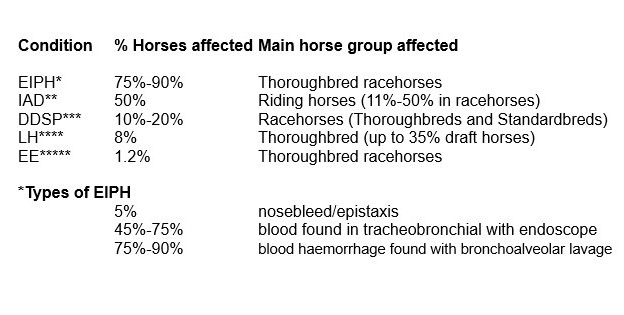
The point needs to be made that Equinamity is not asserting that a direct correlation of rollkur exists with each and every one of the above problems. It is a much more complex relationship. However, it needs to be pointed out that, apart from injury, illness, physical abnormality and genetics, that the above problems by and large originate from accelerated airflows through the respiratory tract. And many of them are created by some form of artificial impediment. Whatever the origin of the problem it will not be improved by a narrowing of the windpipe.
The major conditions identified above are shown next.
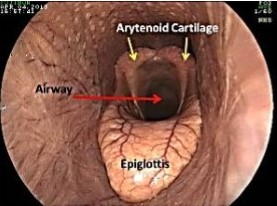
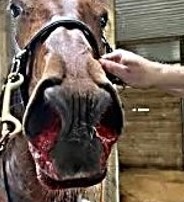
“EIPH-is a performance-limiting condition of racehorses that also affects horses involved in other high-intensity pursuits, such as polo and eventing. Occasionally, cases occur in horses used for other disciplines, such as showjumping and dressage. Clinical signs are limited to poor performance, stopping during exercise, epistaxis and sudden death during exercise. No consensus exists on what constitutes EIPH, but it is most often defined as the presence of visible blood in the trachea on endoscopic examination”.

“IAD-Inflammatory Airway Disease is also described as mild to moderate Equine Asthma. This is a respiratory disease that typically affects young horses, as early as one year of age. Cough, poor performance and excess mucus within the airways on endoscopy is characteristic of IAD. This disease differs from other horse respiratory conditions like heaves, in that affected horses typically do not show increased respiratory efforts at rest. Its exact cause is unknown, but is thought to be associated with inhalation of irritants such as barn dust and air pollution. The most important factor in improving your horses’ health is to decrease environmental irritants especially hay dust.”
“The term equine asthma was introduced recently to unify the terminology of chronic pulmonary inflammatory diseases and, more importantly, because of strong similarities between the syndrome in horses and certain phenotypes of asthma in humans.
Mild-moderate equine asthma (MEA), previously known as inflammatory airway disease, is a common cause of coughing and poor performance in young athletic horses. Studies estimate the prevalence of MEA based on evidence of excess tracheal mucus of around 13% to 22% in racehorses, 31% in sport horses, and 20% in pleasure horses.
During inhalation, the soft palate rests dorsal to the epiglottis but does not cause obstruction because inspiratory pressures maintain it in a relatively stable position on the floor of the nasopharynx. However, during exhalation the soft palate billows dorsally into the nasopharyngeal lumen, thus diverting some flow of air through the oropharynx and mouth. This flow pattern is associated with decreased expiratory airflows and increased expiratory impedance (Rehder et al 1995, Holcombe et al 1998).”
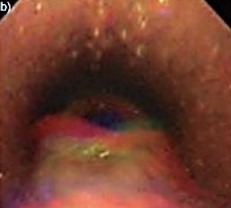
“Palatal dysfunction is very common in performance horses. Its dysfunction is most commonly observed in Thoroughbred or Standardbred racehorses (reported prevalence around 10–20%; Ducharme 2006; Pollock et al. 2009), but also occasionally affects other types of horses, particularly those that are exercised with their head and neck in a flexed position, such as dressage horses and Saddlebreds (Franklin et al. 2006). The horse has an intranarial larynx and the caudal border of the soft palate normally fits snugly around the base of the epiglottis. Palatal instability is seen as wave-like ‘billowing’ of the rostral and caudal soft palate but without actual displacement of the caudal border of the soft palate dorsal to the epiglottis. This condition causes turbulent airflow within the nasopharynx and commonly precedes DDSP (Kannegieter and Dore 1995)”
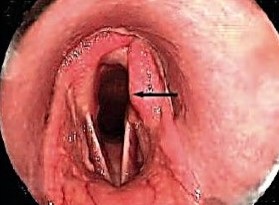
The Dick Vet Equine Practice states: “Recurrent laryngeal neuropathy (RLN) is a common disease of horses that has been recognised for centuries. The disorder usually affects the left side of the larynx (voice box) and occurs most commonly in larger horses. The term recurrent laryngeal neuropathy is more accurate than other names that have been used for this condition such as ‘laryngeal hemiplegia’ or ‘laryngeal paralysis’ because these two terms describe complete immobility of one (hemiplegia) or both (paralysis) sides of the larynx and therefore do not encompass the full spectrum of disease seen in horses.”
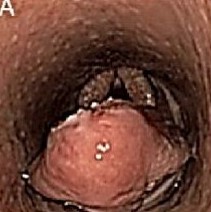
Source: [email protected], wp
“The epiglottis–the movable, leaf-shaped cartilaginous structure located at the base of the tongue and above the soft palate–serves as a “diverter valve” during swallowing. That is, during swallowing, the epiglottis covers the opening of the larynx to ensure that food and water do not enter the trachea, but instead pass into the esophagus. When a fold of tissue, called the aryepiglottic fold, abnormally enfolds the epiglottis, the epiglottis is said to have become “entrapped.”
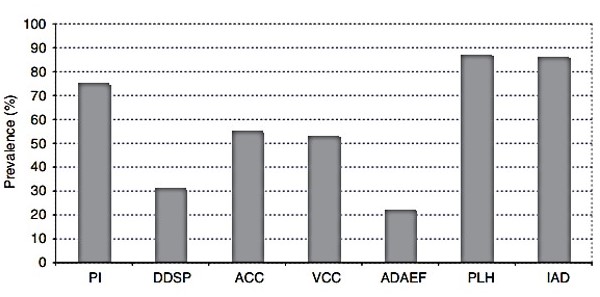

One fundamental conclusion to be drawn from the above statistics is the significant level of DDSP in dressage horses (+65%) vs showjumpers (+30%) and the overall level quoted by Barakzai and Hawkes for athletic horses (10%-20%)
As shown in this post, the speed of the airflow is one problem. When airflow accelerates it becomes turbulent which creates additional difficulties. This aspect is looked at in the next post.